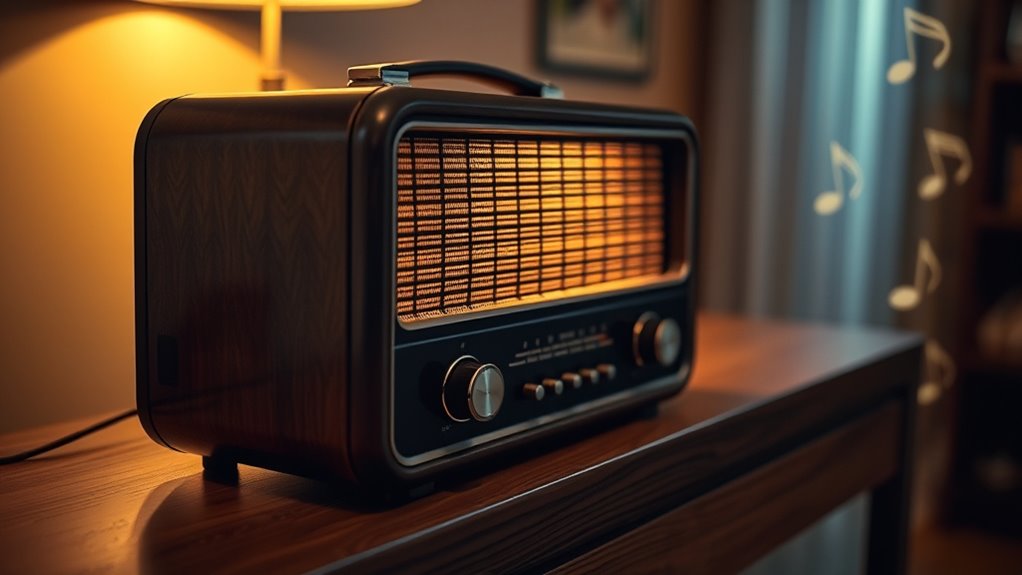Music syncs act like a radio answering your deepest questions by subtly guiding your emotions and perceptions. Carefully chosen songs and lyrics resonate with your feelings, clarifying or revealing new insights about scenes or moments in movies and ads. These musical selections tap into your subconscious, creating a powerful emotional connection. When done thoughtfully, music becomes more than background; it becomes a dialogue that helps you understand yourself better. Keep exploring to discover how this art shape your experience even more.
Key Takeaways
- Music syncs influence emotional responses by subtly guiding perceptions and feelings during scenes.
- Carefully selected lyrics act as a “radio” that resonates with viewers’ subconscious questions and emotions.
- The right song clarifies complex feelings or offers new insights, deepening audience engagement.
- Thoughtful curation of music creates a dialogue between visuals and audio, answering emotional or narrative “questions.”
- Music’s subconscious impact helps audiences connect more deeply to stories, enriching their overall experience.

Have you ever noticed how perfectly a song can enhance a movie scene or elevate an advertisement? That’s the power of music syncing—when a song isn’t just background noise but an integral part of storytelling. It’s no accident that certain melodies and lyrics stick with you long after the credits roll. When you pay attention, you realize how much thought goes into selecting the right track to match a visual or emotional moment. This process involves more than just picking popular tunes; it often includes deep lyrics interpretation. You might find yourself analyzing every line of a song to understand its true meaning, how it reflects the scene’s mood, or how it resonates with your own experiences. This interpretation adds layers to the emotional impact, making the connection between music and visuals even stronger.
Great songs do more than just sound good—they deepen stories and emotional moments.
For creators, playlist curation becomes a strategic tool. By assembling a playlist that complements a storyline or brand message, they guide your emotional journey. When done well, playlist curation transforms a collection of songs into a cohesive narrative, amplifying the message without words. Think of it like creating a soundtrack for your life or a film; each song chosen carefully to evoke specific feelings or memories. It’s about more than just matching tempo or genre—it’s about aligning lyrics, mood, and tone to craft a seamless experience. Additionally, understanding soaring and gliding techniques can inspire creative ways to think about flow and harmony in music and visual storytelling.
This is where music syncs truly shine. When your favorite commercial or movie scene hits just right, it’s because someone thoughtfully curated the soundtrack, considering lyrics interpretation and emotional cues. The music works on a subconscious level, influencing your perception and feelings. It’s as if the radio is answering your deepest questions through carefully selected melodies and words. The right song can suddenly clarify what you’re feeling or help you see things in a new light. That’s the magic of music syncing—it connects you to the story, to your emotions, and sometimes even to parts of yourself you hadn’t fully understood before.
In essence, music syncs aren’t just about background sound; they’re about crafting an emotional dialogue. Whether you realize it or not, each song’s lyrics and mood serve a purpose—guiding your understanding and enriching your experience. So next time a song perfectly captures a moment, remember that behind that sync is a thoughtful process of interpretation and curation, making the radio’s answer to your deepest questions all the more powerful.
Frequently Asked Questions
How Do Music Syncs Determine Which Song to Play?
You might wonder how music syncs choose which song to play. They determine the song selection based on the project’s mood, target audience, and licensing processes. Licensing guarantees the rights are secured, allowing the music to be legally used. Producers and music supervisors collaborate with rights holders, matching songs that fit the scene or message. This careful process ensures the right song enhances the story while respecting legal boundaries.
Can Music Syncs Predict Future Events Based on Song Choices?
About 65% of people believe in psychic phenomena, and some think musical symbolism connects us to future events. While music syncs can reflect emotions or trends, they can’t predict the future. You might notice patterns, but these are more about subconscious cues than definite forecasts. So, no, music syncs don’t truly predict future events, but they can tap into collective feelings and insights that feel almost prophetic.
Are Music Syncs Personalized for Individual Listeners?
You might wonder if music syncs are personalized for you. They often tap into your emotional resonance, reflecting your feelings and experiences. While some syncs are tailored through algorithms or cultural influence, many are designed to connect with universal themes, making them feel personal. This blend creates a unique experience, making you feel understood and connected, even if the playlist isn’t entirely customized.
How Accurate Are Music Syncs in Answering Personal Questions?
Imagine a lighthouse guiding you through fog; that’s how music therapy and song symbolism work. Music syncs can offer insights, but their accuracy in answering your personal questions varies. They tap into emotional signals, like a lighthouse revealing safe paths. While sometimes precise, they shouldn’t replace personal reflection. Trust your intuition alongside these musical clues, knowing they serve as gentle guides, not definitive answers.
What Technologies Are Used to Develop Music Syncs?
When developing music syncs, developers use advanced algorithms and AI to match music genres to emotional cues. They leverage digital signal processing and machine learning to analyze sound patterns. Licensing challenges often arise with copyrighted music, so they work with licensing agencies or create original compositions. These technologies help guarantee the music syncs resonate emotionally and legally, enhancing the listener’s experience and addressing genre-specific preferences effectively.
Conclusion
As you tune into music that resonates with your soul, it’s like finding a secret doorway to your inner world. Each song becomes a guiding star, illuminating paths you didn’t know existed. When the radio answers your deepest questions, it’s as if the universe is whispering back through melodies and lyrics. Trust these moments—they’re your personal compass, steering you through life’s shadows and sunshine, revealing that sometimes, the best answers come when you least expect them to sing.










